Acme is an online book store and publisher, with a relatively successful and profitable website. Their daily traffic runs at about 3,000 unique visitors a day, and while they don’t sell a ton of books the website is a profitable part of their business.
Acme Ups Customer Engagement On Their Website
In January, 2014, Acme decided it wanted to keep visitors on their website longer. They found that on average, visitors spend about one minute on the site, and views about five pages per visit.
Their thinking was that if they could double or triple these numbers, AND create a more “fun” web environment, they could increase their overall traffic, and increase their sales by a similar amount.
What Acme Did To Engage On The Website
Acme did two things. First they set up a web treasure hunt to encourage people to spend more time on the site searching for “secret discount” coupons on a few of their pages. Discounts ranged from 10 percent to 100 percent, to provide incentive to “hunt” them. Visitors could “hunt” by finding a particular phrase hidden in some of the product pages.
Second Acme decided to do some funny videos about books, authors and reading. They uploaded them to YouTube, and displayed them prominently on their site. The thinking was that by making visiting more fun, customers would spend more time, and have more fun, so they would purchase more.
Results For The Treasure Hunt
In fact, by combining the treasure hunt with their Facebook and other social media pages, Acme hit their goal of significantly increasing page views, and length of stay, AND attracted some new visitors.
So, in terms of activity, they succeeded. But that’s not that important. What is important is whether this increased activity actually ended up profitable.
First, as visits increased, they had to add several new servers to make sure that their web site did not get overloaded. That cost them some significant money. Web traffic can be an overhead cost.
Secondly, they looked at how their customers behaved on their site, confirmed many more page views, and longer stays, but discovered that those who were trying to “play the game”, actually only bought if they found one of the big discount coupons. In fact, the discounts had to be at least 50 percent off to show an increase in sales. Otherwise, when customers found the coupons, they just left upon discovering that they weren’t saving much, if anything at all.
Thirdly, it was clear that the new customers they attracted, didn’t buy, again until they could get something almost for free.
Unfortunately, it worked out that to get increases sales using this gamification process, they had to promise to sell at least some items for a loss, and that didn’t work out.
So, Acme stopped the program in April after a three month trial. They considered having some sorts of games that didn’t involve discounts, like some embedded games, cut correctly decided that these might increase page views, but would distract from the buying process.
Results Of The Videos And Customer Engagement
Acme appeared to hit the jackpot since one of their videos went “viral” and was seen by over one million people around the world. Again, site visits increased, as did page views, and particularly length of stay on the site. However, YouTube was the one that gained the most.
Acme’s initial feeling was to create a brand image of fun using the videos, assuming that as potential customers got to know them, and trust them and their style, they’d be more likely to buy.
It didn’t work out that way. What they found was that for both new and existing customers, they’d come to the site to view the video, stay for the length of the video, then leave without viewing any other product pages.
They decided that there was no relationship between sales and customer engagement on their websites, and terminated attempts to create more videos.
Final Outcomes And Points On Customer Engagement
Acme found:
- Simply increasing visits from new customers wasn’t working because the reason people came was to play the game, and/or watch the video — in short, to be entertained. Almost none of the new visitors converted into sales.
- Attempts to engage worked with the wrong population. While they wanted to engage with the book buying public, they actually engaged with a sector that wasn’t interested in buying books.
- While the outlay of case to improve engagement was not huge, they didn’t increase sales, and ended up allocating a lot of human resources to this project. The result was revenue negative.
Conclusion
This scenario is fairly typical except that most companies don’t measure the results in terms of revenue, but deem something a success by looking at activity. A superficial look at the wrong metrics (visitor numbers, length of web stay, page views) would make it appear that the endeavor was hugely successful.
However, more detailed analysis showed it was not. It contributed hardly a penny to online sales.
The moral of the story is that you have to engage the right audience and convince them to do the “right things” that will increase sales (one example actually involves writing and reading book reviews, something that’s almost standard on book sites, and CAN work well.
However simply increasing activity is not necessarily something that impacts on the bottom line.
Code: mxyzpiockle






